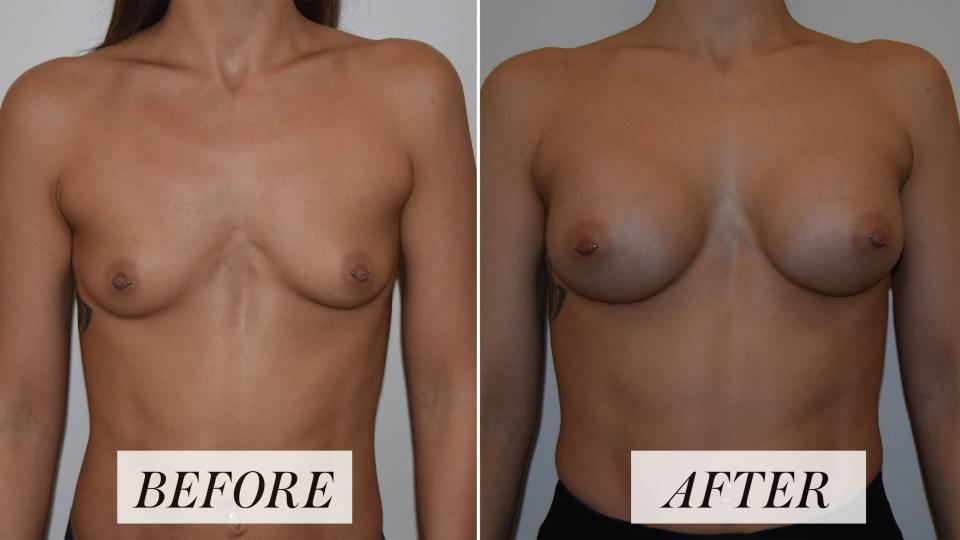The Complete Guide to Breast Augmentation
Note: This article contains images of breasts.
Interest in plastic surgery is at an all-time high, but stigma and misinformation still surround the industry and its patients. At Allure, we believe in choosing whatever is right for your body, and in providing all the information you'll need to make that decision. Welcome to Life in Plastic, a brand-new column that breaks down cosmetic procedures using expert insight and first-person accounts — no judgment, just the facts. Here, we’re covering everything you need to know about breast augmentation.
Breast augmentation, colloquially known as a "boob job," has become an increasingly popular plastic surgery procedure. In fact, according to the American Society of Plastic Surgeons, breast augmentation has become the most commonly performed cosmetic surgical procedure over the last decade. In just 2017 alone, more than 300,000 surgeries were performed. (Three-hundred thousand!)
For those who are looking to transform their breast size and shape, surgical breast augmentation could be the solution. Here's everything (and we do mean everything) you need to know about the procedure.
The Consultation
Breast augmentation, or breast implants, involves the strategic placement of carefully selected implants within the patient's preexisting breasts. But before you can book a spot in the operating room, the first step in the process is an in-depth consultation with your plastic surgeon, which takes anywhere from 60 to 90 minutes, says Daniel Maman, a board-certified plastic surgeon in New York City. During the consult, both the patient and physician discuss in detail the options available, along with any surgeon recommendations "pertaining to implant type, positioning of the implant in relation to the muscle, and incision location," he says.
The Decision
Currently, there are different types of inserts to consider: saline and silicone breast implants, according to the ASPS. Saline inserts are filled with sterile salt water and typically come in a more uniform, one-size-fits-all type of size. Silicone implants, on the other hand, are made with silicone gel and feel more like "natural breast tissue."
Even after you pick the type of implant, there's still the shape and size to consider. Say, for instance, you decide on silicone. Did you know there are three different shapes of silicone implants? These include "smooth round, textured round, and textured anatomical teardrop implants," says Maman. Round implants give breasts a fuller look in person, while smooth inserts feel softer.
"Textured implants have a slightly lower rate of capsular contracture (scar tissue forming around the implant), and implants tend to move around less when they are textured." Though, he says he never uses textured round implants and mainly sticks to the smooth round type, as textured implants have a higher rate of rippling, and risk of an extremely rare lymphoma disease (ALCL), too.
The initial consultation conversation is then followed by 3D imaging so patients can have a chance to determine their size preferences and to "actually see what their own body looks like with implants." Cool, huh? A sizing appointment then takes place weeks prior to the surgery to finalize decisions, but even then, the treatment isn't necessarily set in stone. "I enter the operating room with multiple sizes available and then make the final decision as to which implant fits the best and looks the most natural," Maman says.
The Ideal Candidate
Breast augmentation is a fairly straightforward procedure, as it's "easy for the patient to undergo, and recovery is brief and only mildly uncomfortable," says Darren M. Smith, a board-certified plastic surgeon in New York City. Therefore, he describes the ideal candidate as someone who is in good health and desires an increase in their breast size. Those who have sagging, also known as ptotic breasts, are not advised to have this operation alone, says Smith. "A breast-lift, with or without breast augmentation, is required to address ptosis."
However, those who are planning an "imminent" pregnancy should also avoid the procedure, as pregnancy and breastfeeding "will change the shape and volume of the breasts," he says.
The Preparation
Like most surgical procedures, the prep process for breast augmentation begins six weeks in advance. During this time, patients are advised to stop smoking and using tobacco and nicotine products, as well as cutting out hormonal birth control methods. This is because smoking can interfere with the healing process (as well as increase the risk of complications), says Smith. As for the hormones? "Hormone-based birth control increases the risk of blood clots," he adds.
Then, about 10 days out, prospective patients are given a laundry list of rules to follow. "We ask patients to stop drinking red wine and steer clear of ibuprofen, aspirin, and medications containing those products, as these compounds can thin the blood and increase the risk of bleeding," says Smith. Doctors also recommend reducing your supplement intake (think: vitamin E, omega 3s, etc.) for the same reason.
Two days leading up the main event, patients are asked to indulge in a little self-care — sans that glass of wine — with a bath of special disinfectant soap. (Alcohol consumption is prohibited at this time.)
"Perhaps the most important part of this entire process, is good communication between physician and patient, says Smith. "This is to ensure that the surgeon fully understands the patient's expectations and desires, while the patient understands his or her own role," he says. "The best outcomes result when the patient and surgeon are partners."
The Procedure
The surgery itself, to place and secure the implants, is typically done as an outpatient procedure and takes about an hour and 15 minutes in total. Here's how it works: There are three main sites for incision (inframammary, which is the crease below the breast; periareolar, the border of the areola and breast skin; or transaxillary, which is through the armpit.) Additionally, there are two positions the implant can be placed: either behind the pectoralis major muscle or behind the breast tissue but in front of the muscle. "By far, the most popular choice for breast augmentations in my practice is submuscular placement via an inframmamary approach," says Smith. Meaning most patients prefer their surgeon to go in under the breast.
That approach begins with an incision in the inframammary fold, and the pectoralis muscle is then identified and incised, explains Smith. Next, a pocket behind the muscle is carefully dissected and an implant sizer is placed to confirm the patient's choice of size and pocket shape. Once confirmed, the sizer is removed, any adjustments are made, the implant is placed, and the incision is closed. The same procedure is then performed on the opposite breast, says Smith.
Risks
As with any surgical or invasive procedure, there are some risks involved, along with potential complications. The ASPS advises that possible breast-augmentation surgery risks include "anesthesia risks, bleeding/hematoma, infection, changes in nipple or breast sensation, poor scarring, wrong or faulty position of time implant, implant leakage or rupture, the formation of tight scar tissue around the implant, fluid accumulation, wrinkling of the skin over the implant, persistent pain, and the possibility of revision surgery." That said, all potential risks and complications should be discussed in full with your surgeon prior to the signing of any consent forms.
Recovery and Downtime
In regard to recovery, under a long-acting anesthetic that makes the patient virtually pain-free for 72 hours, patients typically spend about one hour in post-operation recovery and are then sent home. Painwise, though, "most patients report a sensation of chest tightness and soreness, not pain," says Maman.
Most breast augmentation patients can return to work in three to five days, and activity restrictions that limit heavy lifting and upper-body exercise remain in place for two weeks. (Unfortunately, Barry's Bootcamp fans, you'll have to put your membership on hold during that time.) "Usually, patients feel so good after one week, we need to slow them down so that their body can heal fully," says Maman.

Physicians may also recommend that patients wear surgical bras for about two weeks following surgery for added support. Aside from physical support, visiting your provider postprocedure is an important part of the recovery process. Typically, follow-ups are fairly frequent, with appointments "three days post-op, one week, two weeks, four weeks, six weeks, three months, six months, and then every year," says Maman. "I personally like seeing my patients more often than most to make sure they are healing perfectly," he says.
The Cost
As most, if not all, cosmetic procedures are not covered under insurance, they are typically considered full out-of-pocket expenses. Maman says patients can typically expect to pay "usually in the $6,000 to $15,000 range," while pricing can vary based on geographical region and the physician's area of training and expertise. He stresses, "You get what you pay for."
The Experience
Surgeons and patients often eagerly chronicle their experiences through social media, sharing impressive before and after photos. Breast-augmentation recipient Jessica, 34, who recently underwent the procedure, is extremely happy with both her decision to get the implants and her results. "I had always been skinny and flat-chested," she tells Allure. "I just wanted to have a more feminine figure that also looked natural."
Jessica recalls experiencing soreness for a couple of days after surgery, but adds, "by the end of the week, I was pretty much back to normal." Based on her experience, she advises anyone considering the procedure to do their research, as she had been to three different doctors before deciding on her surgeon. "You have to go with a doctor who makes you feel comfortable and listens to you," she says.
If you're considering breast augmentation (or any other cosmetic procedure), it's imperative to seek out a board-certified plastic surgeon for an initial consultation.
For more plastic surgery trends:
Plastic Surgery Trends for 2018 Are Being Shaped By Social Media
Meghan Markel Is Already Inspiring This Plastic Surgery Trend
Now, watch as a dermatologist explains lip injections:


